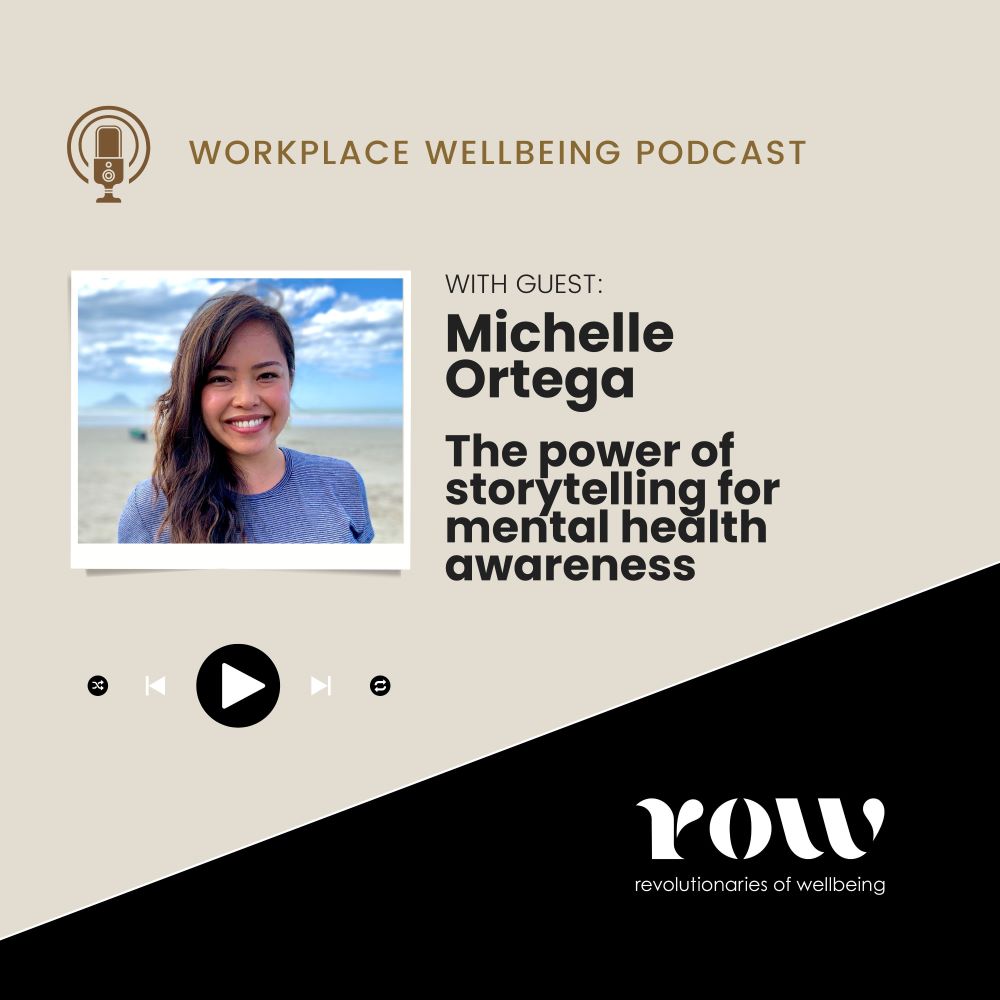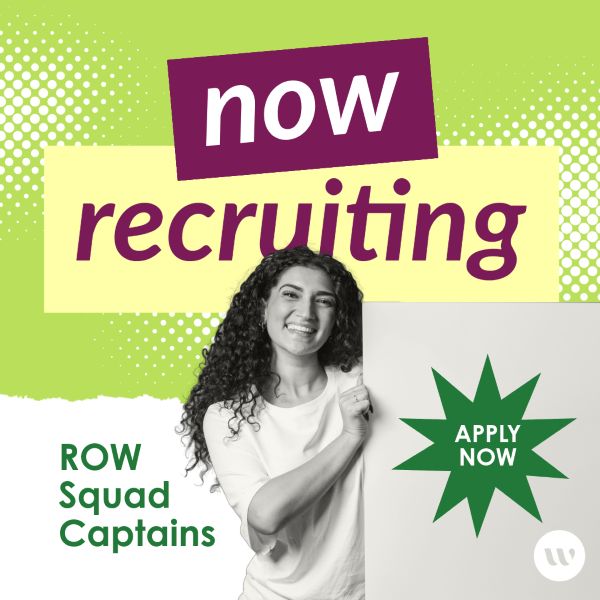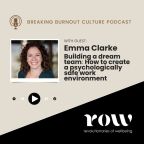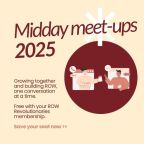Humans have been sharing stories since the dawn of time to help us make sense of the world around us and to influence our thinking. Storytelling is one of the most powerful tools in a wellbeing leader’s toolkit. With it, you can normalise conversations about mental health and wellbeing, you can destigmatise, you can challenge and change beliefs and you can foster psychological safety.
In this episode, we’re delighted to be joined by Michelle Ortega, wellbeing advocate and Communications and Relationship Manager at Fonterra Brands. Join us as we explore how you can use storytelling to create an empathetic, psychologically safe work environment and shape a culture that supports mental health.
Michelle is a passionate advocate for mental health, using her own lived experience to reduce stigma and drive positive mental health conversations in the workplace. Because of her dedication to raising awareness of mental health at Fonterra through openly sharing her own story, Michelle took home the PWC New Zealand Lived Experience Leadership Award at the 2021 HeadFit Awards. Michelle has also presented and has been a keynote speaker at a number of national and international conferences. Most recently at the HR ANZ Summit in the Gold Coast, where she received a standing ovation for her presentation on The Power of Storytelling in Turning the Tide on Mental Health Awareness in Workplaces.
“Most importantly for me, when I’m sharing stories like this, is that I always end with hope, right? Because other people reading it, you want them to feel hopeful for their future too.”
Listen on your favourite platform
Discover the ROW Workplace Wellbeing Podcast on popular platforms such as Spotify, Apple, Google, Amazon Music/Audible and iHeartRadio.
We value your feedback! Please consider leaving a review on your preferred podcast platform, such as Apple Podcasts or Spotify. Let us know what you enjoyed most about this episode.
Where to get help
If you find the content of this story upsetting or need support, it’s completely normal and a positive step to seek help. Taking this step can be daunting, but it’s important. Please visit the website HelpGuide for helplines in your country, or contact your workplace’s Employee Assistance Program (EAP).
Episode insights
Episode Summary
Key points
This episode covers:
• The power of storytelling in creating psychologically safe workplaces
• Michelle Ortega’s personal journey with mental health
• The importance of leader vulnerability in fostering open conversations
• Strategies for sharing personal stories effectively
• Creating a supportive environment for mental health discussions
Detailed summary
1. Michelle Ortega’s personal story
Michelle shares her powerful personal story of overcoming childhood trauma, bullying, and mental health struggles. This deeply personal account demonstrates the impact of storytelling in creating empathy and understanding around mental health issues.
2. The power of storytelling in the workplace
Michelle emphasises the transformative power of sharing personal stories in professional settings. She:
• Recounts her first experience sharing her story at a Fonterra mental health awareness event
• Highlights how this event became a turning point, inspiring her to advocate for mental health awareness
• Discusses the ripple effect of openness, encouraging others to share their experiences
• Stresses the importance of ending stories with hope to inspire positive change
3. Strategies for effective storytelling
Michelle outlines key considerations for sharing personal stories:
• Be intentional about your purpose for sharing
• Consider your own wellbeing and support network
• Write down your story to process emotions and decide what to share
• Think about your audience and desired outcomes
• Include content warnings for potentially triggering material
• End with hope and information on available support
• Let your personality shine through in your writing
4. Creating psychologically safe workplaces
The discussion explores how organisations can foster environments where people feel safe to be vulnerable:
• Encourage open conversations about mental health
• Ensure support mechanisms are in place for those sharing their stories
• Create clear escalation pathways for peer support networks
• Recognise that vulnerability is a strength, not a weakness
• Aim for workplaces where job performance isn’t judged based on mental health openness
5. The role of leaders in mental health conversations
Michelle highlights the crucial role leaders play in normalising mental health discussions:
• 80% of employees say managers who discuss their mental health struggles help them be more open
• Leaders who show vulnerability empower employees to share their own experiences
• Authentic leadership creates a culture of connectedness and reduces stigma
• Encourages leaders to share aspects of themselves beyond their professional persona
Additional notes:
• Michelle began blogging internally at Fonterra during COVID-19 to foster connection
• Fonterra has a peer support network called ‘goodsorts’ to facilitate mental health awareness
• Michelle emphasises the importance of considering one’s own wellbeing before sharing personal stories
• The discussion touches on the broader context of wellbeing strategies in organisations
• Michelle received the PwC New Zealand Lived Experience Leadership Award at the 2021 HeadFit Awards
APPLYING THIS TO THE WORKPLACE
If you’re thinking about using storytelling as a tool in your workplace, here are some things to consider.
The business case for storytelling
• Increases awareness and reducing stigma around mental health in the workplace
• Creates a more psychologically safe work environment through open conversations
• Empowers employees to seek help and support when needed
• Encourages leaders to role model vulnerability and openness about mental health
• Foster empathy and connection among colleagues
Potential challenges to address:
• Persistent stigma and misconceptions about mental health in some workplaces
• Overcoming stigma and fear around discussing mental health and mental illness at work
• Ensuring proper support for those who share their stories
• Balancing vulnerability with professionalism in leadership roles
• Potential for storytellers to feel vulnerable or exposed when sharing personal experiences
• Lack of formal training in creative writing or storytelling techniques
• Possible triggering of painful emotions when sharing personal stories
• Potential negative feedback or criticism when sharing personal stories publicly
• Risk of employees feeling their job performance may be judged if open about mental health
• Challenges in maintaining boundaries and support for peer support volunteers
Top tips for listeners:
• Continue to promote storytelling as a tool for mental health awareness
• Encourage leaders to model vulnerability and openness about mental health
• Develop support systems for those sharing their stories
• Create clear pathways for accessing mental health support in the workplace
“According to a lot of research, 80% of employees surveyed said that managers who talked about their mental health struggles helped them be more open about their own experiences.”
TRANSCRIPT
00:01
Sarah: Welcome to the Revolutionaries of Wellbeing podcast. I’m host Sarah McGuinness. The Revolutionaries of Wellbeing, or ROW, helps leaders to be change makers and to create better workplaces.
With a community of champions from organisations around the globe, ROW is dedicated to helping you to develop your professional expertise, access practical tools and resources, and network with peers and experts to meaningfully improve wellbeing.
These interviews are recorded as part of our monthly Wellbeing Wednesday webinars and are designed to inspire, share ideas and raise awareness of important issues we can all take action on.
, 00:39 [breakout quote]
Michelle: Power of storytelling it’s just one of the most natural ways for us to show up as human beings in the workplace, and workplaces, I find, are simply the most effective way of reaching people. Right? More than ever, people want their workplace to feel where they can find purpose and meaning in life. And so when we do create that culture where people can be themselves, there is a high degree of psychological safety.
, 01:08
Sarah: Humans have been sharing stories since the dawn of time to help us make sense of the world around us and to influence our thinking. Storytelling is one of the most powerful tools in a wellbeing leader’s toolkit. With it, you can normalise conversations about mental health and wellbeing, you can destigmatise it, you can challenge and change beliefs, and you can foster psychological safety. In this episode, we’re delighted to be joined by Michelle Ortega, wellbeing advocate and communications and relationship manager at Fonterra Brands. Join us as we explore how you can use storytelling to create an empathetic, psychologically safe work environment and shape a culture that supports mental health. Michelle is a passionate advocate for mental health, using her own lived experience to reduce stigma. Because of her dedication to raising awareness of mental health at Fonterra through openly sharing her story, Michelle took home the PwC New Zealand Lived Experience Leadership Award at the 2021 Headfit awards. She’s also been a keynote speaker at a number of national and international conferences, most recently at the HRNZ summit in the Gold Coast. She received a standing ovation for her presentation on the power of storytelling and turning the tide on mental health.
, 02:23
Michelle: So I’m Michelle. I live in Auckland in New Zealand and I work at Fonterra, where I’ve been for about six and a half years now, working in a variety of different roles.
So I just want to say, I guess I’ll be the first ones to tell you that I’m not an expert on the topic of mental health or wellbeing, but it doesn’t mean, I guess, for me. It doesn’t mean I can’t talk about it and share some of the things that have worked for me and others.
And my intention has never been to tell anybody what to do. As I said, I’m not an expert, but I’ve never felt the need to be, because I feel like I’ve just got a certain set of experiences and observations, and all my work now is about telling my story in the hope that it will create the permission for other people to do the same. I always like to say showing up and walking into a conversation about mental health, albeit imperfectly, is better than not walking in at all.
So when I first started, when I first shared my lived experience with mental health distress, which wasn’t that long ago, actually. I guess I didn’t really know at the time that not only was I giving myself a chance to get better, but I was also unknowingly paving the way for others who were still also waiting to find their voice.
And as I mentioned, whenever I get asked to present at these conferences or these webinars, I have found that the most impactful way, and obviously the most appropriate way to convey the message is by telling a story. You know, and given this whole presentation is not about the power of PowerPoint or whatnot, it’s about the power of storytelling.
So I was kind of thinking, if I was going to go into a little bit about my long story short, whether you’d be okay for me to share a bit of a story about myself, I would love that. And the reason I ask is because that’s my way of demonstrating why I believe stories do have that power to inspire change and potentially influence people’s attitudes and behaviours and beliefs around the topic of mental health in the workplace.
So, yeah, if you’re keen, I’d love to tell you all the story. And I’m going to share a slide to give you a little bit more something, a holding slide while I’m talking so you don’t have to keep looking at my face. Takes the pressure off me a little bit as well. But for those, for the people that will be listening via the podcast, you won’t be able to see the slide, but I will just do my best to describe it to you.
So, for me, I do this because I feel like if you can turn the most painful moments of your life into something authentic that can help people, then why not? People die in silence every day, and that attention is needed and that attention can save lives.
So this is, this is why I do. I do this. However, before I start, I just have to say some of the things I’ll be talking about might be triggering. So just please make sure that you are in a good frame of mind to hear the story and also that you do have someone that you can speak to should you want to after the session.
So just making sure that you are well looked after in this nimbus as well. Without further ado, a little bit about me. So what you see here and what you see on the slide, and for those who can’t see it, it’s basically what I like to think as a blueprint or a map for this journey that we’re all called on, called. We’re all on called life.
So on one side of it is a little bit about life as a journey, and on the other side are some pictures of me as a child and growing up and through some very important people in my life. So, as I said, that’s basically a blueprint for this journey.
We’re all called on for life. And the stories comes from how we navigate all that life throws our way. As the old saying goes, it’s not the destination that matters, it’s the journey.
And I feel like there’s always a narrative in every aspect of your journey. The highs, the lows, the peaks and the troughs, the roadblocks, the fork in the road.
You just have to find a way of sharing it should you wish to do so. And that is where storytelling comes in. So, this is my long story short. We all have different starting points.
I was born in Manila, Philippines, the eldest of four, so naturally the wisest and destined to become the most successful, as backed up by research, so I’ve been told. When I was seven, we immigrated to New Zealand.
As for those unforeseen events, well, I had my fair share all before I even reached puberty. When I was eight, I suffered extensive trauma at the hands of family members. And much of that period has, you know, I did repress much of that period.
When I was nine, my mum met my stepdad and we moved to his hometown of Whakatani in rural New Zealand. So just when you thought that the journey might finally be leading you somewhere good, you hit some roadblocks and it feels like they never stopped coming. So I finally started primary school when I was ten.
I remember being so excited about the prospect of making friends and settling into some form of normality. But alas, being one of only a handful of asian kids at that school and also had some quite different looking and smelly lunches and broken English I was persistently bullied. When I turned eleven, my stepdad became violent and abusive and we end up living in a women’s refuge shelter, then moving through very state housing until I turned 15 or before I turn 15. Then there are the times when it feels like the road ahead has been paved in darkness and you have no idea if there’s any light at the other end. My first year of high school, I started to develop symptoms of depression and anxiety.
Not that I knew that at the time. I would hide in the library during lunch breaks and I’d struggle to make any sense of life outside the comfort of that I found within the pages of a book, hence books. When I was 15, we moved back in with my stepdad and I started to experience major depressive episodes and panic attacks.
When my stepdad found my diary under my bed and read about all of my deepest and darkest thoughts, instead of trying to understand what was going on, he told me I was crazy and I needed to be locked up in a loony bin.
You could say it was at that point I lost all sense of hope. I tried. I remember trying to call in my best. Tried calling my best friend’s dad, Jim, because I had no one else to turn to. But there was no answer.
So I left a voicemail for him saying goodbye forever. For those who don’t understand depression, when someone is in that place, it’s not because they want to die. It’s because the ongoing relentless darkness and hopelessness is too painful to endure anymore and you feel like you have no other option. I remember that moment like it was yesterday.
Standing on top of that building, staring down at my imminent fate, wishing that the darkness would just end well, as the universe would have it. At that very moment, my Nokia brick phone started to vibrate in my pocket.
I ignored it, but it just kept ringing and ringing. And so I picked up. It was my best friend’s foster dad, Jim, who’s now my foster dad. He’s in that photo, in one of those photos in the middle there.
He was calling to tell me that I was loved and that the world was a much better place with me in it. I’ll never forget that moment. No matter how much I talk about it, I’ll never forget that moment.
And it never fails to make me feel you know something? Because all it took for someone to pull me from that edge was a phone call. So at 15, I moved out of home and became legally emancipated. I worked in a cafe to supplement this government welfare I was getting, and I scraped enough high school credits to get into university.
In my first year of uni, I was finally diagnosed with PTSD, anxiety and depression.
And albeit a couple of years behind my peers, I did eventually graduate. I took some time off to work through things, but I eventually graduated with a degree in business, management and economics.
Don’t ask me if I use it. I do not the first, and I was the first ever in my family to do so. And for the first time, I felt truly proud of myself and how far I had come. But don’t get me wrong, my mental distress is not, you know, it’s not something that’s ever really gone away, but I’ve just become much better at dealing with it.
And that’s why I feel it’s so important to get that help that you. That you need to acquire those tools that you can help to manage, that can help you manage your mental health.
I come across this quote before. I’m not sure if you’ve heard it, but it’s basically, if you don’t make time for your wellness, you’ll be forced to make time for your illness. And I think that that is so true for me. Yeah, there was a turning point after this, but it only came 13 years after I was diagnosed.
, 12:35
Sarah: I’d love to hear about that turning point, Michelle.
, 12:38
Michelle: As I said, you might be surprised to know that despite having lived with a mental illness, mental health distress, for over two decades, it was actually only four, five years ago now when I finally plucked up the courage to open up about my mental health struggles.
And at work, of all places at the time, our health safety and wellbeing committee, which a chair had been planning for mental health Awareness week, and we were looking for something different to do to celebrate and recognise that week.
So what we decided was we would invite people who were comfortable within, you know, in the office to come and share a little bit about their personal story of living with, you know, a mental distress condition, a mental health condition.
So I was one of those people. There are the five of us. That was a first for many, it was the first time an event like that had ever happened at Fonterra, and the first time most of those panel of speakers had ever talked about their story with anyone at work, let alone a massive auditorium of people.
But it was a huge turning point for me in a life changing event, because it gave me purpose and it gave me the motivation to do what I do now, which is really use my lived experience to advocate for mental health awareness.
Looking back on that day, I remember the only thing that got, that held me together in the lead up to the event was knowing that if I got through to at least one person, that it was all worth it. And that’s why a lot of us that do this, do this.
When I stood up in that room, I was paralysed by self doubt. And sometimes when I still talk about it, I still often feel a sense of that, but it’s less and less so, and I’ve been able to manage it a lot better. You know, I had a lot of shame about what I was going for, what I was about to share, but I knew there was no turning back.
Firstly, I was, you know, I’d already signed up and I didn’t really want to drop out. It was tough. But I also knew things had to change.
I strongly feel no one should ever have to feel like their mental health defines them and that they’re a lesser person because of something that is largely out of their control. And through that one session, we witnessed the power that openness has on our ability to talk about a topic which, unfortunately, is still heavily plagued with stigma.
But it also brought about a feeling of hope that things can change one person and one conversation at a time. So following that event, that’s essentially when I heavily pursued putting in place a mental health awareness campaign at Fonterra and putting in place a way to support our people through peer support.
So I won’t go into too much more of that. But that was essentially the turning point for a lot of things in my life. And as I said, I’m not an expert in mental health. It’s not a job I’ve ever done either. Everything that I’ve kind of put into this has been because it means so much to me to share with people that it’s possible to feel okay even after dealing with something like that.
, 16:08
Sarah: That is a hugely powerful story, Michelle, and I’m so grateful and appreciative that you’ve shared that with us so openly. And I can imagine every single one of us in the room will be feeling something in response to that part.
Kind of like, oh, my goodness, to, oh, my gosh, I want to wrap you in a hug to, you know, all those kind of human responses that we have, you know, when someone shares something like that.
So I just want to first acknowledge and thank you so much for sharing that with us. And actually, almost, I was thinking about that response piece. You know, there’s a. I’m going to terribly paraphrase this. Brene Brown says something along the lines of, you know, when you share your story, it becomes someone else’s survival guide.
So tell me about some of those responses that you’ve had when you shared that story. I mean, the standing ovation. But do people come up afterwards and share their own stories? Do you get emails? What’s some of the kind of response you get?
, 16:59
Michelle: I mean, I wasn’t planning on sharing this slide, but this is just some of the quotes that I’ve pulled from emails that I’ve had from people. But again, I guess that’s just a bonus of it.
All right, going into and doing this, I started blogging at Fonterra during COVID So that was three years ago. And I just, we were all sitting at home and we’re all feeling just like, you know, we’re all in the same boat, we’re all in the same storm, maybe not in the same boat, but I just felt so strongly that we needed to feel more connected even when we weren’t together.
And so I started, I started this internal, basically mental blog and Fonterra, and it just took off and essentially had a pretty nice following and allowed me to heal through sharing as well and taught me a lot about the best, the most, the safest and most effective way to share your story, all the sort of things that you need to consider before you even, you know.
Yeah, before you even step into that. And so I was really, yeah, been really privileged that Fonterra has allowed me to kind of do that because it was quite unprecedented for someone to be sharing so much of their own, you know, personal insights and feelings, but it also encouraged other people to do that and which was, you know, the most powerful thing out of it.
, 18:42
Sarah: And I was thinking about that in telling your story, because I imagine there was a fair amount for your brain to get to, to organise the events. And how do I want to say this, and what are the things I want to share? And what was the process for you and kind of working out what that looked like?
, 18:58
Michelle: Yeah, that’s a really good question. So there’s this kind of little guide that in a couple of excerpts of my couple of blogs I’ve written, I kind of always think about these things whenever I feel like I’m wanting to share a story.
And so for me, it’s a powerful story, takes the audience on a journey they otherwise wouldn’t have gone on. And so that journey is all around the thoughts and emotions and beliefs, which is driven by empathy for the person that’s sharing it.
And so I don’t have a creative writing class, I’m not a writer or anything, but this isn’t about learning how to craft stories. It’s about understanding the impact that personal stories can have and how it doesn’t have to be written and told in a perfect way.
It just needs to be authentic, and that’s the main thing. So everyone has stories to share, and so you just have to find a way of doing that and be really intentional about it. So kind of ask yourself, why am I sharing this?
You know, what’s my purpose for it? What’s your motivation for sharing that? Is it to help other people, but also a big one is making sure that you’re considering your own wellbeing before deciding to share the putting your own oxygen mask on, as it were.
Telling your lived experience in a public way can stir up some quite deep and sometimes painful emotions.
So it’s really important to consider how your support network can help you if that happens. I find it much easier writing my story down before sharing because that process allows me to discharge some of those emotions that may surround what I’m sharing and also can help me determine what I want to share and what I want to keep private.
Because you don’t have to share everything, right? You have to also think about your audience. What do they need? How do you want them to feel or act after your presentation or your talk or what you’ve written? Are you hoping to educate people? Are you hoping to inspire change, etcetera? You know, do you want people to fall asleep?
In which case I have lots and lots of words and lots of slides. But essentially what you’re wanting, what you want to do is if you’re wanting to plan to share something that could be triggering and difficult to read, consider including a content warning, kind of like what I did at the start, because oftentimes people won’t realise that they will be triggered.
So I just kind of put that out there to make people feel safe. Most importantly for me, when I’m sharing stories like this, is that I always end with hope, right?
Because other people reading it, you want them to feel hopeful for their future too. You know, you want to be able to communicate through how you’re expressing your words that change is possible.
And there is definitely ways to pull yourself out of this, you know, out of that feeling, should you ever be in that situation. So that’s the most important thing, is to actually make sure that people know that there’s support available.
And just remember, you don’t have to be a writer. You just have to let your personality come through in your writing. And so I find writing as if you are talking helps.
, 22:41
Sarah: I love that. And one of the things that you’ve talked about a couple of times is that support network and making sure you’ve got support around you. So if I go back to, if you’re sharing your story, what kind of support would you have around you or do you have around you?
, 22:52
Michelle: Yeah, that’s a really good question because we have, when you’re part of a peer support network. Right. And, or you’re, you know, at Fonterra, we have what’s called ‘good sorts’, and they’re basically people who can facilitate workshops around mental health awareness, et cetera.
But they’re also kind of like people who you can go to, who can signpost you for further support. So for that group of people, for them, it’s really important to understand what their boundaries are, but also know that they’re supported because, yes, we have, you know, we might have these passionate group of, passionate group of people who just want to help, but we need to make sure that they’re supported as well.
The business needs to make sure from a risk perspective. And so for me, I’ve create, I’ve had, I’ve learned to put in place an escalation pathway for myself to be able to really effectively set those boundaries and making sure that that group of peer support know that they have somebody that they can go to if they feel affected.
So there’s lots of different things that I do, but I think it’s really important if you are going to get into this type of advocacy and if you are going to, if you are wanting to share your story to help people that you do consider having a support mechanism around you, whatever that may look, whatever works for you, basically.
, 24:21
Sarah: Yeah. And as an extension of that, it sounds like both yourself and the team at Fonterra have done quite a lot of work around making the space psychologically safe for people to tell stories and for that openness. And so what sits behind that or what kind of work have you been involved in?
, 24:37
Michelle: You’re right. In order for me to have felt comfortable sharing my story, I needed to feel safe to do it right. So it all does relate back to that sense of psychological safety. It’s about opening up that space and making it safe for people to share. And I think that’s probably one of the main things that’s going to allow us to be truly authentic at work, is psychological safety.
I know it’s become a bit of a buzzword, but it’s, it’s a real thing. It’s the confidence that. It’s the confidence that we can be vulnerable.
And that’s welcome without fear of embarrassment, rejection, you know, or punishment even. What I guess I try to do as an individual is create that safe space because it’s important. It’s been so important for me for my sense of belonging. It’s about me feeling safe to be myself and accepted for who I am, but also empowered to share those learnings and make that meaningful contribution.
I strongly believe that when we witness someone else’s vulnerability, particularly leaders in a safe and supportive environment, we do feel less alone. Stories are what connects us as human beings, and we need them more now than ever.
All I do, I guess, is try to hold that space for people when they come forward with their stories, because those who might put themselves out there, they might feel a new sense of susceptibility and being visible, exposed and vulnerable.
And so we need to make sure that the cost of coming forward and talking about your lived experience isn’t a burden and that coming forward is okay just as it is. Taking the time or not wanting to.
Really, it’s all about that environment that you are part in. Are these types of conversations encouraged and welcome in your workplace? Yeah.
, 26:43
Sarah: Yeah. Oh, and I think that that’s really important is around that, that encouragement. And as you said, that safety to share. And when I shared my burnout story, you know, most of the time in person, people would come and be really supportive.
And I suppose it was almost the Facebook warriors, the stuff comment warriors, who would write the negative comments. And so I guess on that point, have you ever along the way, and I guess this is a question for those listening and thinking about sharing their story and thinking, well, what if I get up there and I am going to get all this negative feedback? Did you receive any? And if so, how have you managed it or processed it?
, 27:15
Michelle: Yeah, that’s a really good question. And having been quite prolific and public, like on LinkedIn, etcetera, with my own journey, there was a little bit of anxiety around, hey, what are people going to think? What are people going to say?
But at the same time, I kept coming back to, if I can get through to someone who’s feeling vulnerable or feeling like they don’t matter or that they’re alone, other people have it better.
Or if I can get through to someone and make them feel comfortable to even reach out to me and I can get them for help, further support, that’s all that ever has really mattered.
I’ve actually not ever had anyone come to me with negative feedback or email me anything. I’ve had a couple of people suggest, you know, you could frame that in this way and it will come across, you know, it would relate more to a certain group of people, et cetera, or relate more, be more relevant for a bigger group of people, etcetera, then I’ve done that.
I’ve taken that on board, but that’s been constructive feedback and I’ve not seen that as negative. And also, I think, at that, when I was at the height of writing my blogs and speaking, people really, really needed it at that point in time. I’m sure people still do, actually.
In fact, they do. But back then, when we were the onslaught of COVID and everything that was happening, I felt like that was a good opportunity and it propelled a lot of these discussions, which is something that I wanted to leverage.
, 28:55
Sarah: And that’s the gold, isn’t it? That’s the bit that no matter what gets said, in what context, as you said, it’s that reaching out to that one person and making a difference, and it outweighs the rest of it.
There’ll be some organisations who are starting to think about this, and in fact, we’re doing some work with an industry body about to embark on this journey. And so when you’re moving into sharing, what are some of the considerations more broadly across an organisation, if you want to start a campaign or around storytelling and inviting people to share?
, 29:27
Michelle: I always liked. I always kind of go back to the power of storytelling in terms of the impact that it has as a whole, and the impact that I’ve seen from doing this work at Fonterra.
The power of storytelling, it’s just one of the most natural ways for us to show up as human beings in the workplace. And workplaces, I find, are simply the most effective way of reaching people. Right.
More than ever, people want their workplace to feel where they can find purpose and meaning in life. And so when we do create that culture where people can be themselves, there is a high degree of psychological safety, there is a focus on people, psychosocial health, as well as, you know, everything else.
I think it’s going to be much easier for people to openly speak about how they’re feeling without fear, and it’s easier for them to actually reach out and for help when they need it. And that’s what you want, you offer all the support, but it doesn’t get used.
We shouldn’t expect people to come to work and kind of armour up and leave all their, you know, all that at the door. A telling sign that we’re moving in the right direction with mental health in the workplace is, if you can answer the question with a resounding no, would you feel like your job performance would be judged if you were open about your mental health?
, 31:01
Sarah: That’s such a powerful question. And I feel like there are certainly still some industries, aren’t there, where the answer would be, you know, well, people would feel their job performance would be on the line.
, 31:14
Michelle: Exactly. We need to move away from the perception that a person struggling with their mental health is weak. They’re selfish, they’re broken, self indulgent, incapable, et cetera. Instead, we need to start seeing those things and appreciating them as the strength, a strength that it takes to fight battles that no one else can see.
, 31:39
Sarah: So let’s talk about the role of leaders then. So, I mean, I know it’s one of the things that you talk about quite strongly, that role of leaders in storytelling and enabling that psychological safety. So tell me a bit about that.
, 31:51
Michelle: Yeah, that’s been. When it comes, that’s been really key for me, for my personal journey, storytelling. But more broadly, the role of leader is hugely important.
As I had up on my slide earlier, which you probably can’t see now, is, according to a lot of research, 80% of employees surveyed said that managers who talked about their mental health struggles helped them be more open about their own experiences.
And personally, I found when it comes to encouraging open conversations about mental health and smashing those stereotypes, leaders have a huge role to play. We can’t be what we can’t see.
So seeing leaders role modelling is incredibly impactful. And for leaders, being able to relate to your people on that human level makes them feel more empowered and safe in sharing their own experiences. So I always think, I always say to people, if your manager never showed emotions or never talked about anything that was happening in their personal life, or never shared anything about themselves, would you feel comfortable going up to them and talking to them about your own, you know, how you’re feeling?
And probably not so much leaders who show a little bit of, you know, who they are beyond just kind of the professional side of things. They’re the ones that you feel comfortable talking to, they’re the ones that you actually go to if you are looking for help.
Because what we find is a lot of people don’t go to their managers as a first port of call. They’ll go to a friend. It’s really, these are really kind of big, big role to play there in terms of showing vulnerability as leaders, giving employees that permission to show theirs. Not only does that lead to a culture of connectedness, but it also gets rid of a lot of those really prevalent stigmas around mental health.
But if you are talking about a wellbeing strategy and how this can fall into that, that’s kind of a broader discussion, because this is just one aspect of the mental health discussion, isn’t it? There’s just so much more to it. This is storytelling about your lived experience.
Yes, it opens the door for more discussions, but it is only looking at a subset of people. You go one in five people experience mental health issues. We’ve also got to think about the other, for what are we doing to support them? And how can we use tools like storytelling to create a better narrative around mental health?
To show how accessible it is, to show that our leaders care about it and that we’re putting some investment into it?
, 34:46
Sarah: Thanks again for listening today. It’s been great to have you along. If you’re keen to join the Revolutionaries of Wellbeing, head to rowwellbeing, that’s r o w, wellbeing.com, and follow the links to sign up if you’re in our community. Thanks again, and we look forward to catching up with you really soon.
